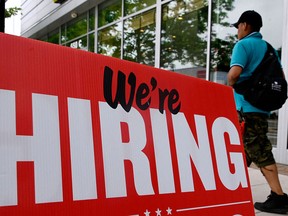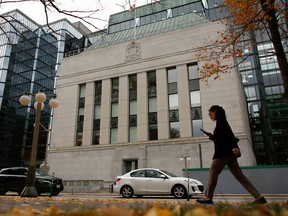Economists react to a surprise burst in September employment
Article content
Canadian jobs data surprised again in September with a net gain of 63,800 positions, more than triple forecasts.
The unemployment rate remained unchanged at 5.5 per cent, said Statistics Canada in its Labour Force Survey, on Oct. 6.
Article content
Most of the gains were in part-time work, said the national data agency, with part-time jobs rising by 48,000 or 1.3 per cent.
The employment rate — those aged 15 and older who are working — rose to 62 per cent, offsetting a decline in the previous month.
Advertisement 2
Article content
Statistics Canada said in its release that the economy would need to generate 50,000 new jobs each month to keep up with soaring population growth and maintain the current employment rate.
Here’s what economists are saying about the jobs report and what the numbers might mean for the Bank of Canada and interest rates.
Nathan Janzen, RBC Economics
“Details of the September labour market data were more mixed than strong headlines would suggest. And there are still signs that hiring demand continues to soften under the surface relative to surging labour supply, with broader unemployment measures pointing to more softening than the official unemployment rate itself implies. Still, it would be difficult for the Bank of Canada to look through very strong top-line employment growth, and wages are showing few signs of decelerating despite signs that labour supply is beginning to catch up to hiring demand. Our own base-case does not assume further interest rate hikes from the Bank of Canada this year — and there is still another monthly inflation report and the closely watched Business Outlook Survey to be released before the central bank makes its next decision on interest rates. But the BoC has been clear that it won’t hesitate to respond with more hikes if necessary to cool labour markets and bring inflation down.”
Advertisement 3
Article content
James Orlando, TD Economics
“The Bank of Canada has been looking for evidence that past rate hikes are starting to bite. Today’s employment report muddies the outlook. Financial markets are cementing pricing for another 25-basis-point rate hike in the coming months, causing the Canada two-year yield to surge over 15 basis points this morning. There will be a lot more data coming out between now and the next BoC rate decision (CPI, housing, retail sales) and the bank will likely need to see significant weakness in these reports to prevent it from pulling the trigger on another hike.”
Tony Stillo, Oxford Economics
“Growth in average hourly wages ticked up to five per cent yer over year in September from 4.9 per cent year over year in July. This remains too high for the Bank of Canada, but we expect ongoing loosening in labour markets amid continued strong population growth and job losses in the emerging recession will cause wage growth to slow sharply over the next year. We expect this will keep the Bank of Canada’s policy rate steady at fiver per cent until mid-2024.”
Brendon Bernard, senior economist, Indeed
Article content
Advertisement 4
Article content
“Strong headline, softer details. The Canadian labour market continues to hold up amid gloomy consumer and business sentiment. While the 64,000 employment increase isn’t especially eye-popping given Canada’s rapid population growth, it was fast enough to push the overall employment rate higher. Throughout 2023, low layoff rates have kept a lid on the unemployment rate, even as GDP growth has flat-lined.
“Not all of the details in the report matched the top-line strength. Hours worked edged down slightly, in part because job gains tilted part-time. Meanwhile, the seasonally volatile education industry was the key driver of the overall increase, while cyclical bellwethers like construction and wholesale and retail trade both dipped.
“Perhaps as surprising as the overall pace of job gains was that wage growth kept chugging. There’s been a steep drop off in Canadian employer recruiting activity, yet paychecks continue to grow briskly, at a five per cent year-over year pace. It’s clear that overall wage growth tends to react with a lag to other developments in the labour market. One area where this is showing up is in the public sector, where pay gains are starting to catch up to recent growth in the private sector. However, with other economic data coming in weak, the headline rate of wage growth could keep inflation lingering for longer.”
Advertisement 5
Article content
Related Stories
-

Canada adds 64,000 jobs in September
-

Falling job vacancies could ease pressure on Bank of Canada
Douglas Porter, BMO Economics
“There is little debate that the gaudy headline job growth overstates the strength of the labour market, juiced by a seasonal spike in education jobs and by surging part-time employment. Still, the fact that overall employment is up 2.8 per cent in the past year and average wages are rising five per cent year over year means that labour income is still powering ahead. In turn, that suggests that the economy is not seriously buckling, yet. We don’t believe this is enough to tip the scales for the Bank of Canada, but it will keep their tightening bias firmly in place.”
Andrew Grantham, CIBC Economics
“While the headline increase in employment was a surprise, the weaker detail and decline in hours worked point to a still sluggish economy to end Q3. With GDP having basically stalled in Q2 and Q3, and without a clear indication that it was accelerating again heading towards the final quarter, we still see the Bank of Canada remaining on hold despite the stronger-than-anticipated inflation readings recently.”
Advertisement 6
Article content
David Rosenberg, Rosenberg Research & Associates Inc.
“What will certainly catch the BoC’s eye is on the wage front, with average hourly earnings of permanent employees jumping 0.7 per cent month over month (seasonally adjusted) after a 0.8 per cent increase in August and one per cent in July. As a result, the year-over-year trend accelerated to 5.3 per cent from 5.2 per cent prior, the fastest pace since February. Unsurprisingly, odds of a rate hike at this month’s (Bank of Canada) meeting on Oct. 25 rose to 45 per cent from 29 per cent as of yesterday. The odds of a hike by the end of the year are now sitting at 75 per cent from 25 per cent prior. This latest BoC pause may be short-lived, based on what markets are thinking.”
Jay Zhao-Murray, currency trader, Monex Canada
“With today’s gravity-defying employment gains and an economy that is still producing uncomfortably high levels of core inflation, it is beginning to look like Canada’s monetary policy is still not restrictive enough even as lagged data indicate that output growth has stagnated. In our view, the Bank of Canada has two options. It can either resume its hiking cycle at its meeting in three weeks, which could become the most likely outcome if September’s inflation data continues to show core inflation running above the range that held for most of the year, or it could signal that rates will remain elevated for an even longer period than markets expect. Markets will be even more sensitive than usual to data surprises over the coming weeks given that monetary policy uncertainty has sharply risen.”
Advertisement 7
Article content
Marc Desormeaux, Desjardins
“Despite the boost to the Canadian labour force, the September print doesn’t meaningfully change our Q3 GDP tracking. More troubling was the third consecutive acceleration in the growth in permanent employees’ wages. The Bank of Canada tracks this indicator closely to assess possible wage-push inflation. We continued to observe an upward trend across many sectors.
“Although the rate of monthly population expansion cooled across the country in September, it continues to outpace job creation by a significant margin. Over time, strong headcount gains should help increase the supply of available workers — particularly with immigrant labour market integration improving — and that can help ease labour market tightness and potential wage-push inflation. But in the current context, the surge in headcount gains risks boosting on demand for goods and services, and by extension generating further upward price pressures.”
Matthieu Arseneau and Alexandra Ducharme, National Bank of Canada
“Historically, a gain of 60,000 jobs should translate into a decline in the unemployment rate, but the latter did not move an iota in September due to continued spectacular population growth. It is therefore important to revise upward the threshold for a good employment report. In fact, employment was barely above the pace that would be expected in the current context of explosive population growth.
Advertisement 8
Article content
“Looking ahead, we continue to believe that the labour market will ease over the next 12 months. According to the latest CFIB (Canadian Federation of Independent Business) survey, labour shortages are easing and concerns about weak domestic demand rose sharply in Q3. As a result, SMEs (small and medium enterprises) intend to raise wages slower than they have recently, which is good news for the wage pressures currently fuelling inflation.”
• Email: gmvsuhanic@postmedia.com
Bookmark our website and support our journalism: Don’t miss the business news you need to know — add financialpost.com to your bookmarks and sign up for our newsletters here.
Article content
Jobs surge: What economists say
2023-10-06 14:27:55






Comments
Postmedia is committed to maintaining a lively but civil forum for discussion and encourage all readers to share their views on our articles. Comments may take up to an hour for moderation before appearing on the site. We ask you to keep your comments relevant and respectful. We have enabled email notifications—you will now receive an email if you receive a reply to your comment, there is an update to a comment thread you follow or if a user you follow comments. Visit our Community Guidelines for more information and details on how to adjust your email settings.